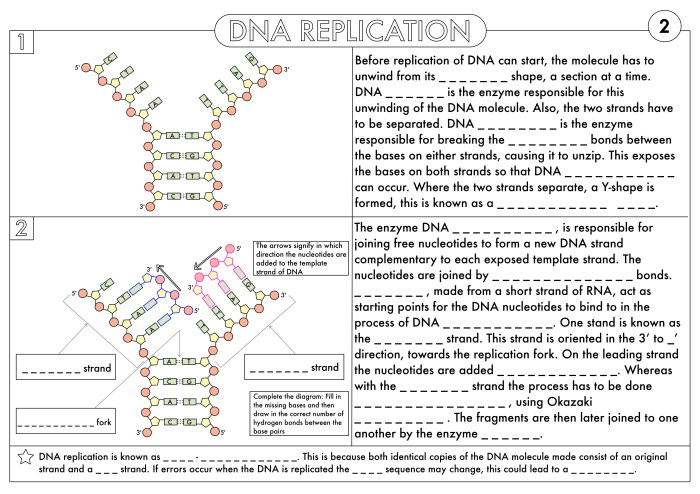Worksheet on dna rna and protein synthesis answer key pdf – Introducing the Worksheet on DNA, RNA, and Protein Synthesis Answer Key PDF, a comprehensive guide that unravels the intricacies of molecular biology. This meticulously crafted resource empowers learners to delve into the fundamental processes that govern gene expression, from the central dogma to the intricate mechanisms of transcription and translation.
Embark on a journey of discovery as we decipher the genetic code and witness the remarkable applications of DNA, RNA, and protein synthesis in biotechnology and medical diagnostics.
Throughout this worksheet, you will encounter a wealth of knowledge, including an overview of the central dogma, the roles of DNA, RNA, and proteins in gene expression, the processes of transcription and translation, and the regulation of gene expression. With its clear explanations, illustrative examples, and comprehensive answer key, this worksheet serves as an invaluable tool for students, educators, and anyone seeking a deeper understanding of molecular biology.
1. DNA, RNA, and Protein Synthesis Overview: Worksheet On Dna Rna And Protein Synthesis Answer Key Pdf
The central dogma of molecular biology describes the fundamental flow of genetic information from DNA to RNA to protein. DNA serves as the blueprint for all genetic information, containing the instructions for building and maintaining an organism. RNA, in the form of messenger RNA (mRNA), carries the genetic code from DNA to the ribosomes, where proteins are synthesized.
Proteins, the workhorses of the cell, perform a vast array of functions, including structural support, metabolic reactions, and cellular communication.
2. Transcription
DNA to RNA
Transcription is the process by which genetic information encoded in DNA is copied into RNA. RNA polymerase, an enzyme, binds to specific regions of DNA called promoters and unwinds the DNA double helix. The exposed DNA strand serves as a template for RNA polymerase to synthesize a complementary RNA molecule.
This newly synthesized RNA molecule, known as pre-mRNA, undergoes further processing, including splicing and modifications, to produce mature mRNA.
RNA Modifications during Transcription
- Capping: A protective cap is added to the 5′ end of mRNA to prevent degradation and aid in ribosome binding.
- Polyadenylation: A tail of adenine nucleotides is added to the 3′ end of mRNA to enhance stability and promote translation.
- Splicing: Introns, non-coding regions within genes, are removed, and exons, coding regions, are joined to form the mature mRNA molecule.
3. Translation
RNA to Protein

Translation is the process by which the genetic code carried by mRNA is decoded to produce a specific protein. Ribosomes, complex molecular machines, bind to mRNA and move along the molecule, reading the sequence of codons, three-nucleotide sequences that specify a particular amino acid.
Transfer RNA (tRNA) molecules, each carrying a specific anticodon complementary to a codon on mRNA, bring the corresponding amino acids to the ribosome. The ribosome catalyzes the formation of peptide bonds between the amino acids, creating a growing polypeptide chain.
The Genetic Code
The genetic code is a set of rules that defines the relationship between codons and amino acids. It is nearly universal, meaning that the same codons code for the same amino acids in most organisms.
4. Regulation of Gene Expression

Gene expression is tightly regulated to ensure that proteins are produced in the right amounts at the right time. Transcription factors, proteins that bind to specific DNA sequences, play a crucial role in regulating gene expression. They can activate or repress transcription by promoting or inhibiting the binding of RNA polymerase to promoters.
Environmental Regulation of Gene Expression
Environmental cues can influence gene expression through various mechanisms. For instance, changes in temperature, nutrient availability, or light exposure can trigger signaling pathways that lead to the activation or repression of specific genes.
5. Applications of DNA, RNA, and Protein Synthesis

The understanding of DNA, RNA, and protein synthesis has revolutionized biotechnology and medicine.
Genetic Engineering, Worksheet on dna rna and protein synthesis answer key pdf
Genetic engineering involves manipulating DNA to create new proteins or organisms. This technology has applications in agriculture, medicine, and industrial biotechnology.
DNA Sequencing and Analysis
DNA sequencing and analysis play a vital role in medical diagnostics, allowing for the identification of genetic mutations associated with diseases and the development of personalized treatments.
Q&A
What is the central dogma of molecular biology?
The central dogma describes the fundamental principle that genetic information flows from DNA to RNA to protein.
What is the role of RNA polymerase in transcription?
RNA polymerase is the enzyme responsible for synthesizing RNA molecules using DNA as a template.
How does the genetic code direct the translation of mRNA into proteins?
The genetic code is a set of rules that determines the sequence of amino acids in a protein based on the sequence of nucleotides in mRNA.
What are the different mechanisms that regulate gene expression?
Gene expression can be regulated at various stages, including transcription, translation, and post-translational modifications.
What are some applications of DNA, RNA, and protein synthesis in biotechnology?
Applications include genetic engineering, protein production, and DNA sequencing for medical diagnostics.